Steel-Reinforced Polyurethane with Mineral Interlayer for Masonry Protection: Laboratory Tests
Abstract
1. Introduction
2. Materials and Methods
2.1. Materials
2.2. Specimen Preparation
2.3. Test Setup and Test Procedure
3. Results
3.1. Reference Specimens
3.2. Cement-Based Interlayer
3.3. Lime-Based Interlayer
4. Discussion
5. Conclusions
- The strength obtained in the test on the bond between the SRPUI composite and the brick substrate was strongly influenced by the mechanical properties of the material used as the interlayer. An increase in shear bond strength was observed for the cement interlayer compared to the lime interlayer. The ratios of maximum axial stress for specimens with a cement interlayer to those with a lime interlayer were 171%, 138%, and 225% for mortar interlayer thicknesses of 3 mm, 6 mm, and 10 mm, respectively. This improvement is attributed to the higher bond, compressive, and tensile strength of the cement mortar. However, the presence of the interlayer led to a reduction in shear bond strength of up to 22% for the cement interlayer with a thickness of 10 mm, and a 65% reduction for the lime interlayer with a thickness of 10 mm, when compared to the reference specimens without an interlayer.
- Regardless of the applied mortar, the shear bond strength of the tested SRPUI systems is influenced by the thickness of the mortar interlayer. For cement mortar, an increase in interlayer thickness resulted in a reduction in shear bond strength. In the case of lime mortar, the lowest strength was recorded for the thickest layer (10 mm); however, the trend was not consistent. It may be attributed to the limited number of specimens and the high coefficient of variation.
- The mechanical properties of the applied material influence the observed failure modes. For specimens with a cement interlayer, cohesive debonding within the substrate was the dominant failure mode, while for specimens with a lime interlayer, failure occurred at the interface between the interlayer and the brick.
- The stiffness of the bond under shear in the tested SRPUI systems was unaffected by the presence of the mineral interlayer. Despite the varying mechanical properties of the materials used as the interlayer, similar stiffness values were observed across all the specimens. This can be attributed to the high deformability of the polyurethane matrix and the relatively rigid nature of the mineral interlayer.
Author Contributions
Funding
Institutional Review Board Statement
Informed Consent Statement
Data Availability Statement
Acknowledgments
Conflicts of Interest
References
- Valluzzi, M.R.; Oliveira, D.V.; Caratelli, A.; Castori, G.; Corradi, M.; de Felice, G.; Garbin, E.; Garcia, D.; Garmendia, L.; Grande, E.; et al. Round Robin Test for Composite-to-Brick Shear Bond Characterization. Mater. Struct. 2012, 45, 1761–1791. [Google Scholar] [CrossRef]
- Valluzzi, M.R.; Modena, C.; de Felice, G. Current Practice and Open Issues in Strengthening Historical Buildings with Composites. Mater. Struct. 2014, 47, 1971–1985. [Google Scholar] [CrossRef]
- Tedeschi, C.; Kwiecień, A.; Valluzzi, M.R.; Zając, B.; Garbin, E.; Binda, L. Effect of Thermal Ageing and Salt Decay on Bond between FRP and Masonry. Mater. Struct. 2014, 47, 2051–2065. [Google Scholar] [CrossRef]
- de Felice, G.; De Santis, S.; Garmendia, L.; Ghiassi, B.; Larrinaga, P.; Lourenço, P.B.; Oliveira, D.V.; Paolacci, F.; Papanicolaou, C.G. Mortar-Based Systems for Externally Bonded Strengthening of Masonry. Mater. Struct. 2014, 47, 2021–2037. [Google Scholar] [CrossRef]
- De Santis, S.; Ceroni, F.; de Felice, G.; Fagone, M.; Ghiassi, B.; Kwiecień, A.; Lignola, G.P.; Morganti, M.; Santandrea, M.; Valluzzi, M.R.; et al. Round Robin Test on Tensile and Bond Behaviour of Steel Reinforced Grout Systems. Compos. Part B Eng. 2017, 127, 100–120. [Google Scholar] [CrossRef]
- de Felice, G.; Aiello, M.A.; Caggegi, C.; Ceroni, F.; De Santis, S.; Garbin, E.; Gattesco, N.; Hojdys, Ł.; Krajewski, P.; Kwiecień, A.; et al. Recommendation of RILEM Technical Committee 250-CSM: Test Method for Textile Reinforced Mortar to Substrate Bond Characterization. Mater. Struct. Mater. Constr. 2018, 51, 95. [Google Scholar] [CrossRef]
- Caggegi, C.; Carozzi, F.G.; De Santis, S.; Fabbrocino, F.; Focacci, F.; Hojdys, Ł.; Lanoye, E.; Zuccarino, L. Experimental Analysis on Tensile and Bond Properties of PBO and Aramid Fabric Reinforced Cementitious Matrix for Strengthening Masonry Structures. Compos. Part B Eng. 2017, 127, 175–195. [Google Scholar] [CrossRef]
- Carozzi, F.G.; Bellini, A.; D’Antino, T.; de Felice, G.; Focacci, F.; Hojdys, Ł.; Laghi, L.; Lanoye, E.; Micelli, F.; Panizza, M.; et al. Experimental Investigation of Tensile and Bond Properties of Carbon-FRCM Composites for Strengthening Masonry Elements. Compos. Part B Eng. 2017, 128, 100–119. [Google Scholar] [CrossRef]
- Lignola, G.P.; Caggegi, C.; Ceroni, F.; De Santis, S.; Krajewski, P.; Lourenço, P.B.; Morganti, M.; Papanicolaou, C.; Pellegrino, C.; Prota, A.; et al. Performance Assessment of Basalt FRCM for Retrofit Applications on Masonry. Compos. Part B Eng. 2017, 128, 1–18. [Google Scholar] [CrossRef]
- Leone, M.; Aiello, M.A.; Balsamo, A.; Carozzi, F.G.; Ceroni, F.; Corradi, M.; Gams, M.; Garbin, E.; Gattesco, N.; Krajewski, P.; et al. Glass Fabric Reinforced Cementitious Matrix: Tensile Properties and Bond Performance on Masonry Substrate. Compos. Part B Eng. 2017, 127, 196–214. [Google Scholar] [CrossRef]
- de Felice, G.; Aiello, M.A.; Bellini, A.; Ceroni, F.; De Santis, S.; Garbin, E.; Leone, M.; Lignola, G.P.; Malena, M.; Mazzotti, C.; et al. Experimental Characterization of Composite-to-Brick Masonry Shear Bond. Mater. Struct. 2016, 49, 2581–2596. [Google Scholar] [CrossRef]
- Napoli, A.; de Felice, G.; De Santis, S.; Realfonzo, R. Bond Behaviour of Steel Reinforced Polymer Strengthening Systems. Compos. Struct. 2016, 152, 499–515. [Google Scholar] [CrossRef]
- Bellini, A.; Aiello, M.A.; Bencardino, F.; de Carvalho Bello, C.B.; Castori, G.; Cecchi, A.; Ceroni, F.; Corradi, M.; D’Antino, T.; De Santis, S.; et al. Influence of Different Set-up Parameters on the Bond Behavior of FRCM Composites. Constr. Build. Mater. 2021, 308, 124964. [Google Scholar] [CrossRef]
- De Santis, S.; de Felice, G. Steel Reinforced Grout Systems for the Strengthening of Masonry Structures. Compos. Struct. 2015, 134, 533–548. [Google Scholar] [CrossRef]
- Rizzo, V.; Bonati, A.; Micelli, F.; Leone, M.; Aiello, M.A. Influence of Alkaline Environments on the Mechanical Properties of FRCM/CRM and Their Materials. Key Eng. Mater. 2019, 817, 195–201. [Google Scholar] [CrossRef]
- Fares, S.; Fugger, R.; de Santis, S.; de Felice, G. Durability of Stainless-Steel Reinforced Grout against Salt Attack. Key Eng. Mater. 2022, 916, 43–49. [Google Scholar] [CrossRef]
- Fares, S.; Fugger, R.; De Santis, S.; de Felice, G. Strength, Bond and Durability of Stainless Steel Reinforced Grout. Constr. Build. Mater. 2022, 322, 126465. [Google Scholar] [CrossRef]
- Ghiassi, B. Mechanics and Durability of Lime-Based Textile Reinforced Mortars. RILEM Tech. Lett. 2020, 4, 130–137. [Google Scholar] [CrossRef]
- Dalalbashi, A.; de Santis, S.; Ghiassi, B.; Oliveira, D.V. Cyclic Load Effects on the Bond Behavior of Textile Reinforced Mortar (TRM) Composites. Key Eng. Mater. 2022, 916, 74–81. [Google Scholar] [CrossRef]
- De Santis, S.; AlShawa, O.; de Felice, G.; Gobbin, F.; Roselli, I.; Sangirardi, M.; Sorrentino, L.; Liberatore, D. Low-Impact Techniques for Seismic Strengthening Fair Faced Masonry Walls. Constr. Build. Mater. 2021, 307, 124962. [Google Scholar] [CrossRef]
- Fares, S.; Fugger, R.; de Santis, S.; de Felice, G. Tensile and Pull-Out Behavior of Steel Reinforced Grout Connectors. Key Eng. Mater. 2022, 919, 72–79. [Google Scholar] [CrossRef]
- Akyildiz, A.T.; Kwiecień, A.; Zając, B.; Triller, P.; Bohinc, U.; Rousakis, T.; Viskovic, A. Preliminary In-Plane Shear Test of Infills Protected by PUFJ Interfaces. In Brick and Block Masonry—From Historical to Sustainable Masonry; CRC Press: Boca Raton, FL, USA, 2020; pp. 968–975. [Google Scholar]
- Hojdys, Ł.; Krajewski, P.; Kwiecień, A.; Rousakis, T.; Vanian, V.; Tekieli, M.; Viskovic, A.; Ilki, A.; Gams, M.; Rakicevic, Z.; et al. Quick Repair of Damaged Infill Walls with Externally Bonded FRPU Composites: Shake Table Tests. J. Compos. Constr. 2023, 27, 04022084. [Google Scholar] [CrossRef]
- Kwiecień, A.; Rakicevic, Z.; Bogdanovic, A.; Manojlovski, F.; Poposka, A.; Soklarovski, A.; Rousakis, T.; Ilki, A.; Gams, M.; Viskovic, A. PUFJ and FRPU Earthquake Protection of Infills Tested in Resonance. In Proceedings of the 1st Croatian Conference on Earthquake Engineering, Zagreb, Croatia, 22–24 March 2021; University of Zagreb, Faculty of Civil Engineering: Zagreb, Croatia, 2021; pp. 465–476. [Google Scholar]
- Lasowicz, N.; Kwiecień, A.; Jankowski, R. Experimental Study on the Effectiveness of Polyurethane Flexible Adhesive in Reduction of Structural Vibrations. Polymers 2020, 12, 2364. [Google Scholar] [CrossRef]
- Kwiecień, A.; Krajewski, P.; Hojdys, Ł.; Tekieli, M.; Słoński, M. Flexible Adhesive in Composite-to-Brick Strengthening—Experimental and Numerical Study. Polymers 2018, 10, 356. [Google Scholar] [CrossRef] [PubMed]
- Kwiecień, A.; de Felice, G.; Oliveira, D.V.; Zając, B.; Bellini, A.; De Santis, S.; Ghiassi, B.; Lignola, G.P.; Lourenço, P.B.; Mazzotti, C.; et al. Repair of Composite-to-Masonry Bond Using Flexible Matrix. Mater. Struct. 2016, 49, 2563–2580. [Google Scholar] [CrossRef]
- Zając, B.; Kwiecień, A. Thermal Compatibility of Rigid and Flexible Adhesives to Substrates of Historical Structures. In Structural Analysis of Historical Constructions: An Interdisciplinary Approach; Aguilar, R., Torrealva, D., Moreira, S., Pando, M.A., Ramos, L.F., Eds.; Springer: Berlin/Heidelberg, Germany, 2019; pp. 1868–1877. [Google Scholar]
- Kwiecień, A.; Gams, M.; Viskovic, A.; Zając, B. Temporary and Removable Quick Seismic Protection Ofweak Masonry Structures Using Highly Deformable Adhesives. In Structural Analysis of Historical Constructions: Anamnesis, Diagnosis, Therapy, Controls, Proceedings of the 10th International Conference on Structural Analysis of Historical Constructions, SAHC, Leuven, Belgium, 13–15 September 2016; CRC Press: Boca Raton, FL, USA, 2016; pp. 1528–1535. [Google Scholar]
- Garbin, E.; Panizza, M.; Kwiecień, A.; Zając, B.; Nardon, F.; Valluzzi, M.R. Testing of Bond Solutions for UHTS Steel Strand Composites Applied to Extruded Bricks. In Proceedings of the 16th International Brick and Block Masonry Conference, Padova, Italy, 26–30 June 2016; CRC Press: Boca Raton, FL, USA, 2016; pp. 395–402. [Google Scholar]
- De Santis, S.; Stryszewska, T.; Bandini, S.; de Felice, G.; Hojdys, Ł.; Krajewski, P.; Kwiecień, A.; Roscini, F.; Zając, B. Durability of Steel Reinforced Polyurethane-to-Substrate Bond. Compos. Part B Eng. 2018, 153, 194–204. [Google Scholar] [CrossRef]
- Carozzi, F.G.; Arboleda, D.; Poggi, C.; Nanni, A. Direct Shear Bond Tests of Fabric-Reinforced Cementitious Matrix Materials. J. Compos. Constr. 2020, 24, 04019061. [Google Scholar] [CrossRef]
- Kwiecień, A.; Hojdys, Ł.; Krajewski, P.; Tekieli, M. FRPU Composite Protection of Masonry with Reversible Mineral Interlayer. In Proceedings of the Structural Analysis of Historical Constructions, Kyoto, Japan, 11–15 September 2023; Endo, Y., Hanazato, T., Eds.; Springer: Cham, Switzerland, 2024; pp. 873–883. [Google Scholar]
- EN12190:1998; Products and Systems for the Protection and Repair of Concrete Structures—Test Methods—Determination of Compressive Strength of Repair Mortar. European Committee for Standardization: Brussels, Belgium, 1998.
- Kwiecień, A.; Hebel, D.E.; Wielopolski, M.; Javadian, A.; Heisel, F. Bamboo Fibre Reinforced Polymers as Highly Flexible Reinforcement of Masonry Structures in Seismic Areas. In Proceedings of the 12th International Symposium on Fiber Reinforced Polymers for Reinforced Concrete Structures (FRPRCS-12) & the 5th Asia-Pacific Conference on Fiber Reinforced Polymers in Structures (APFIS-2015) Joint Conference, Nanjing, China, 14–16 December 2015. [Google Scholar]
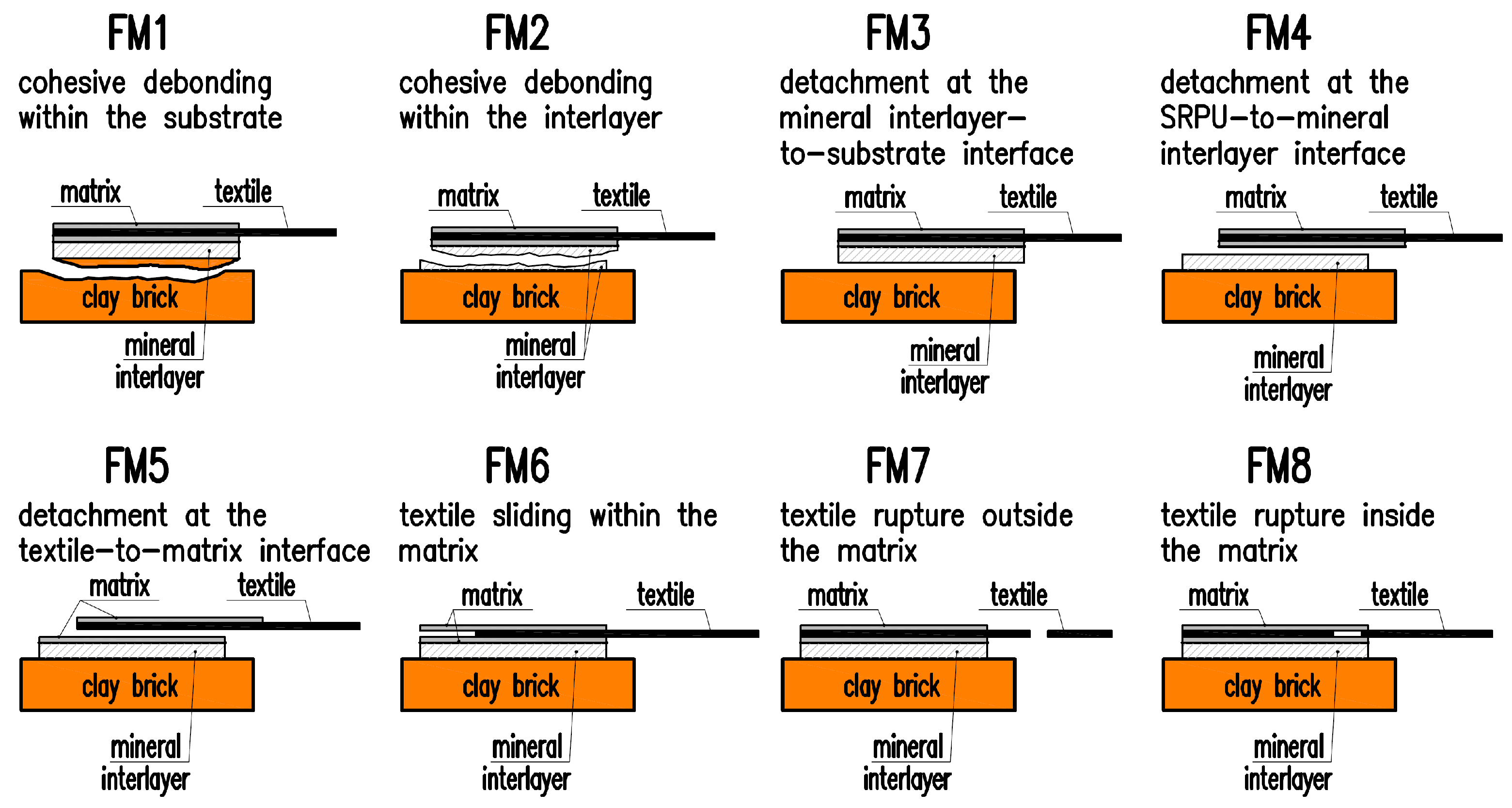
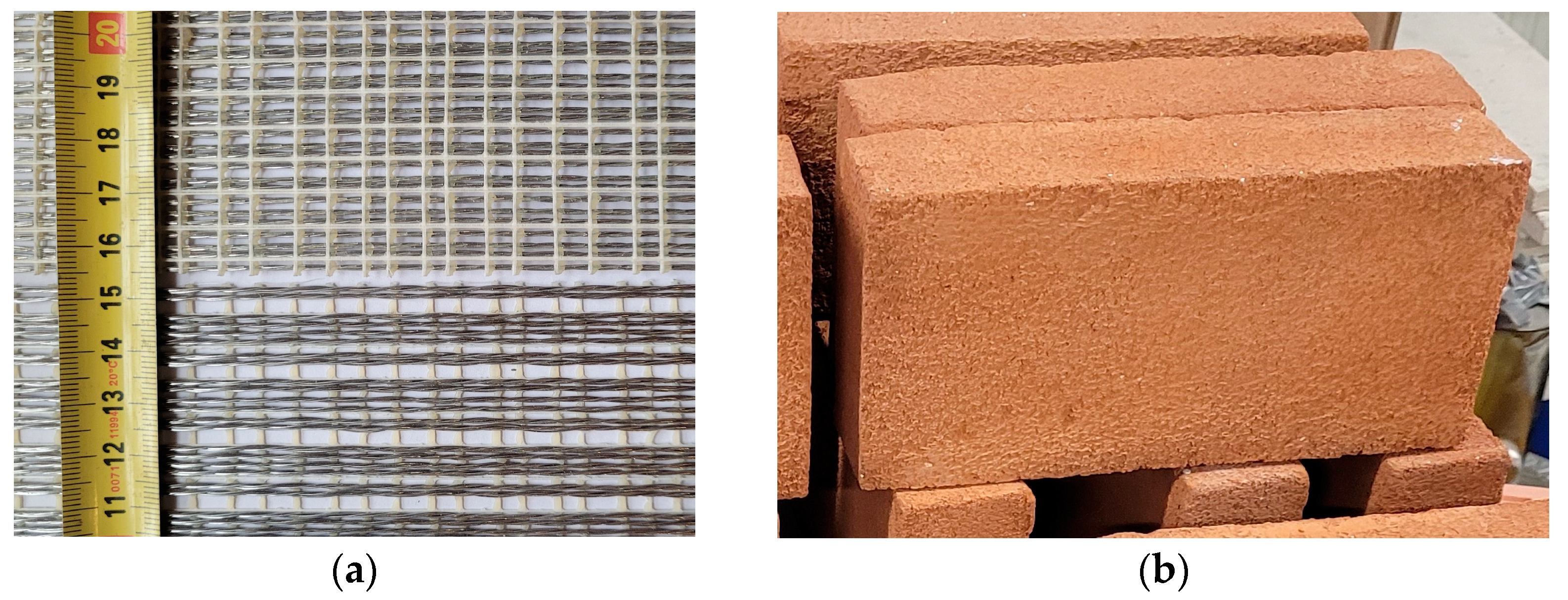
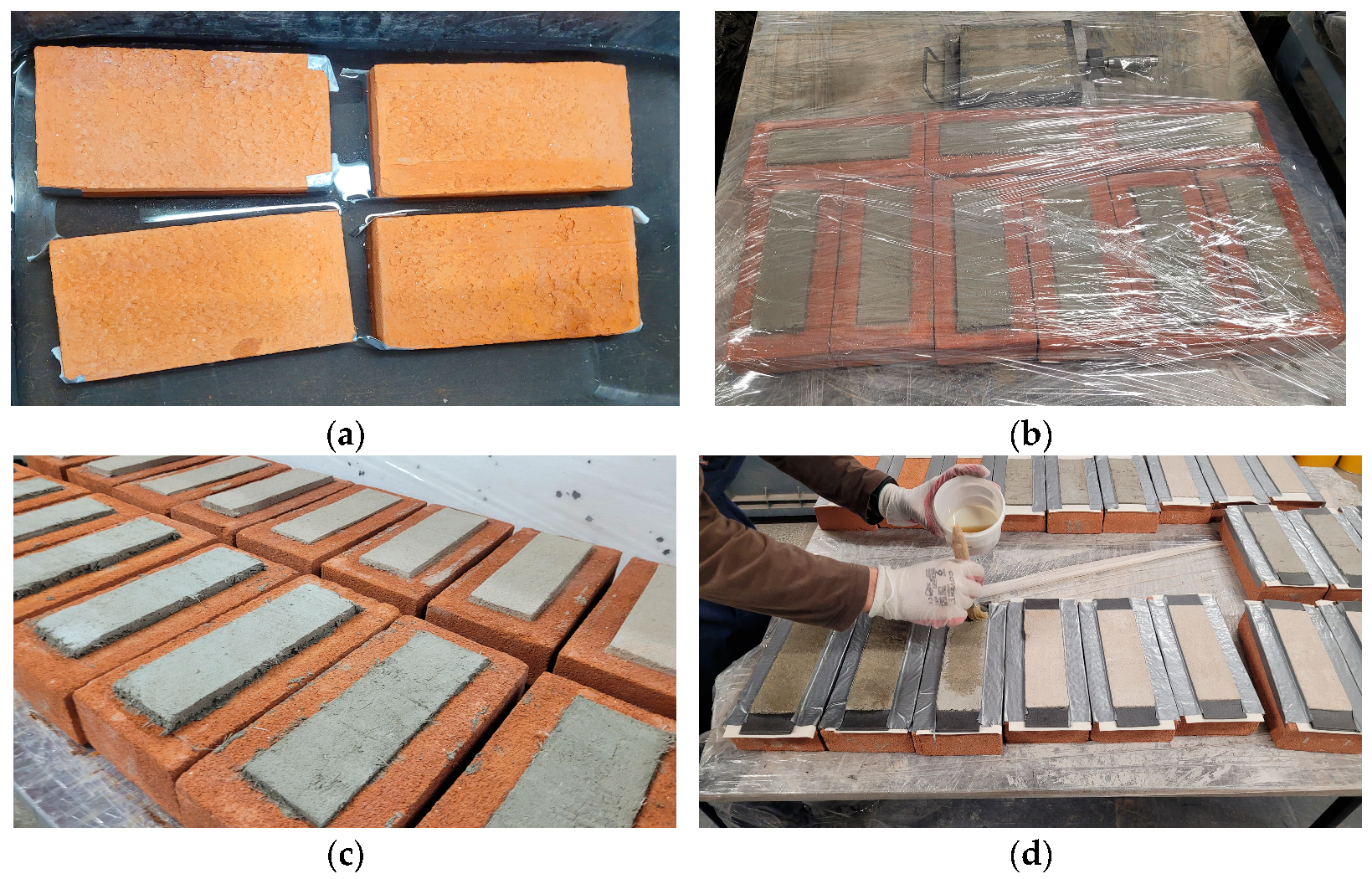
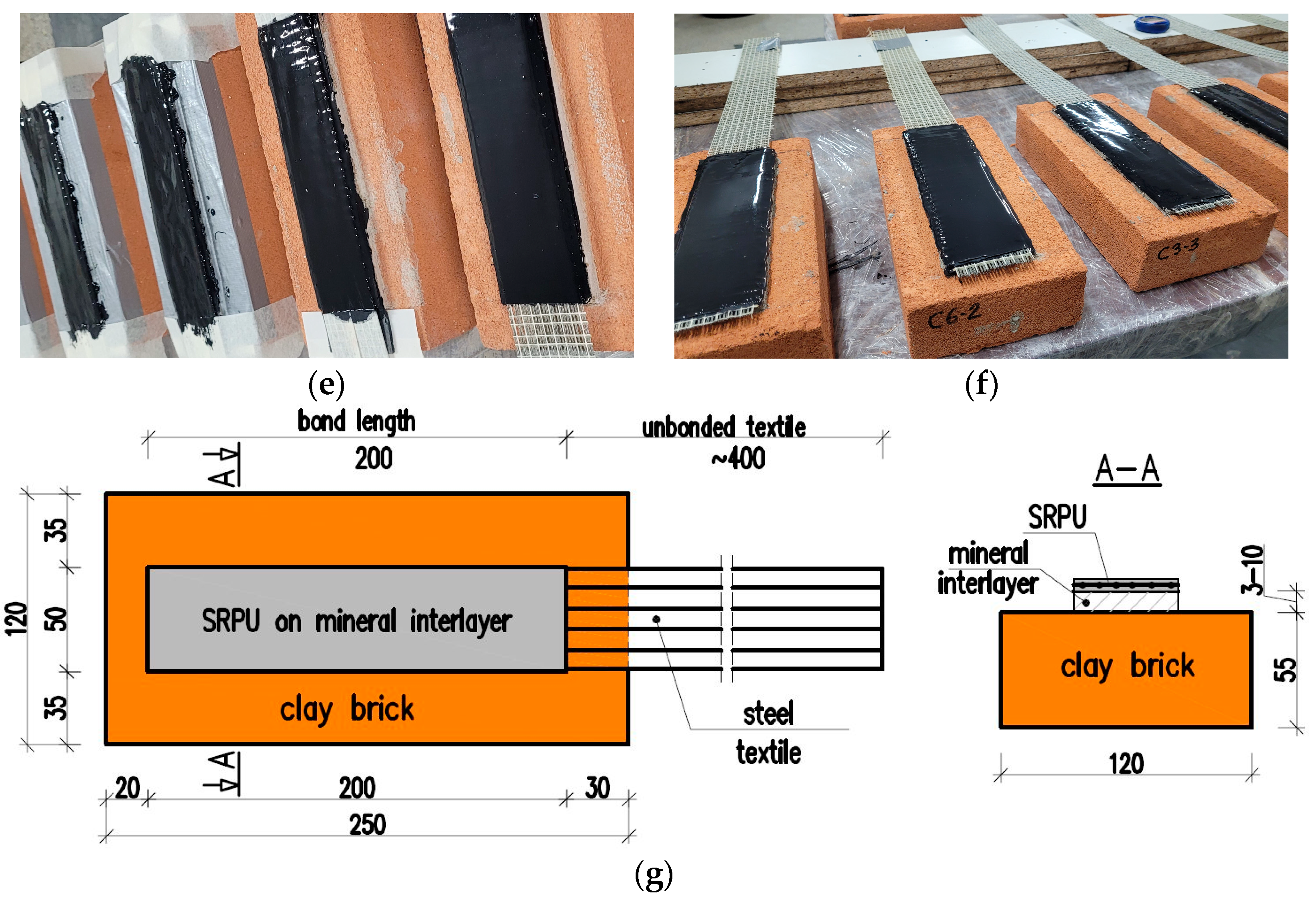
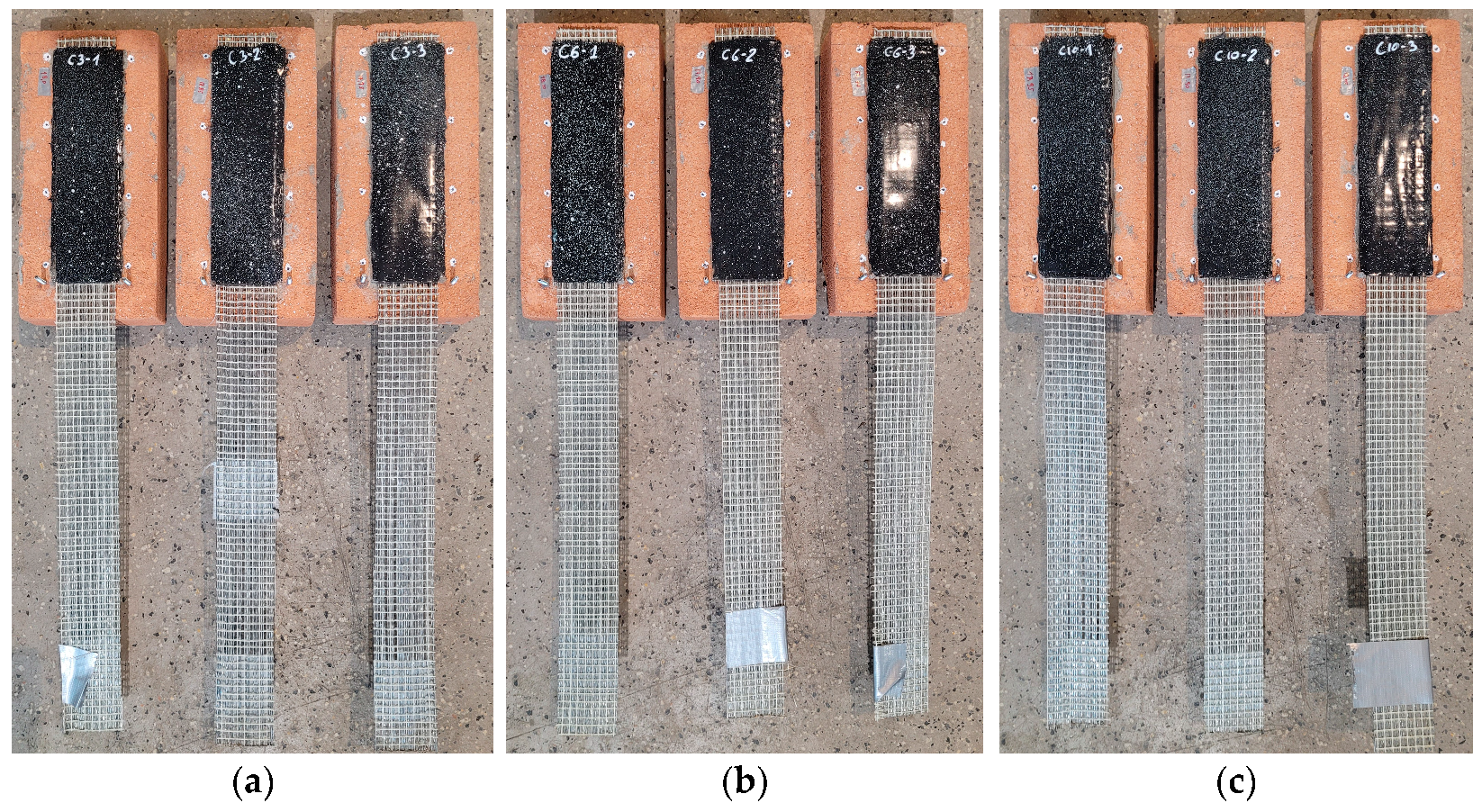

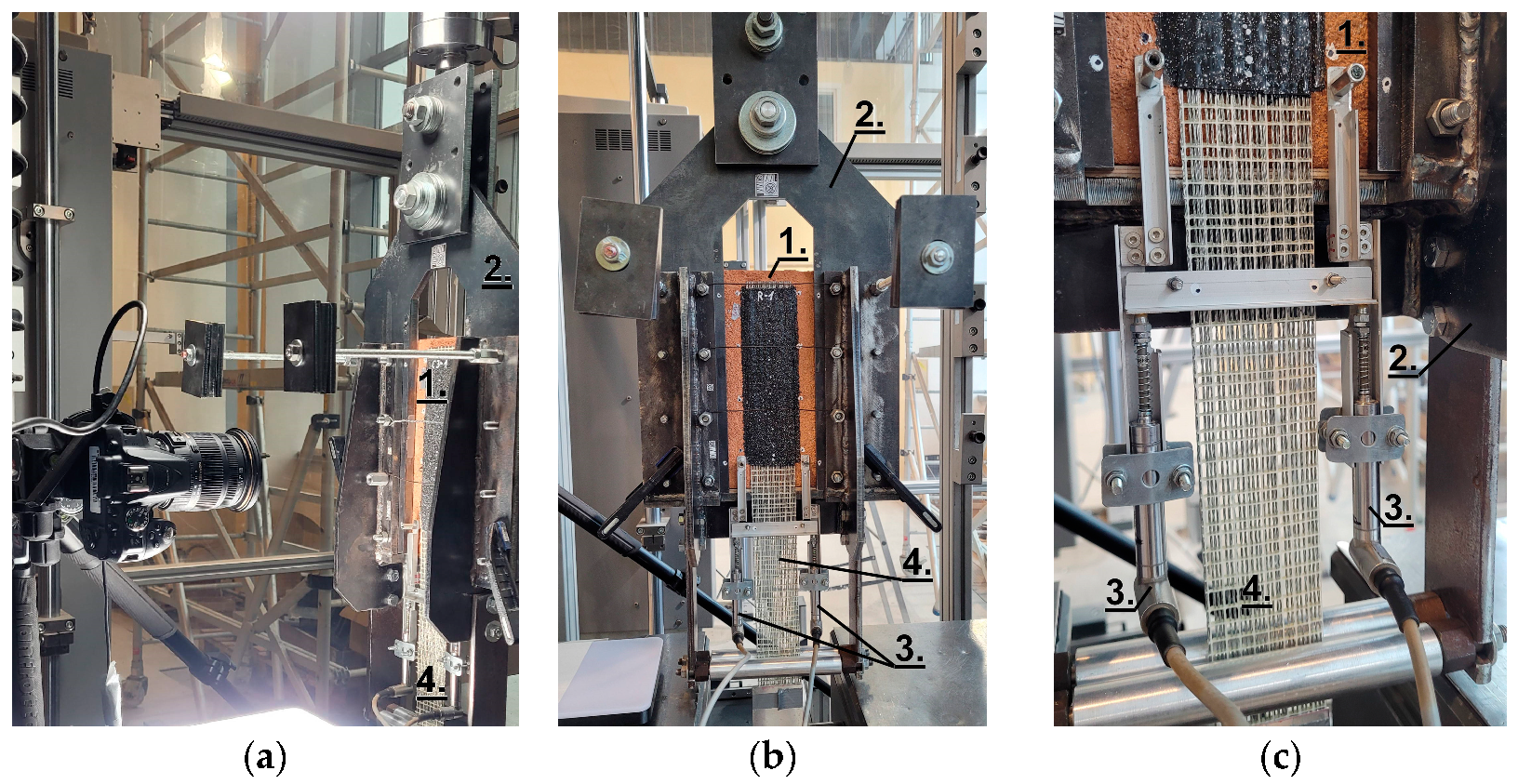

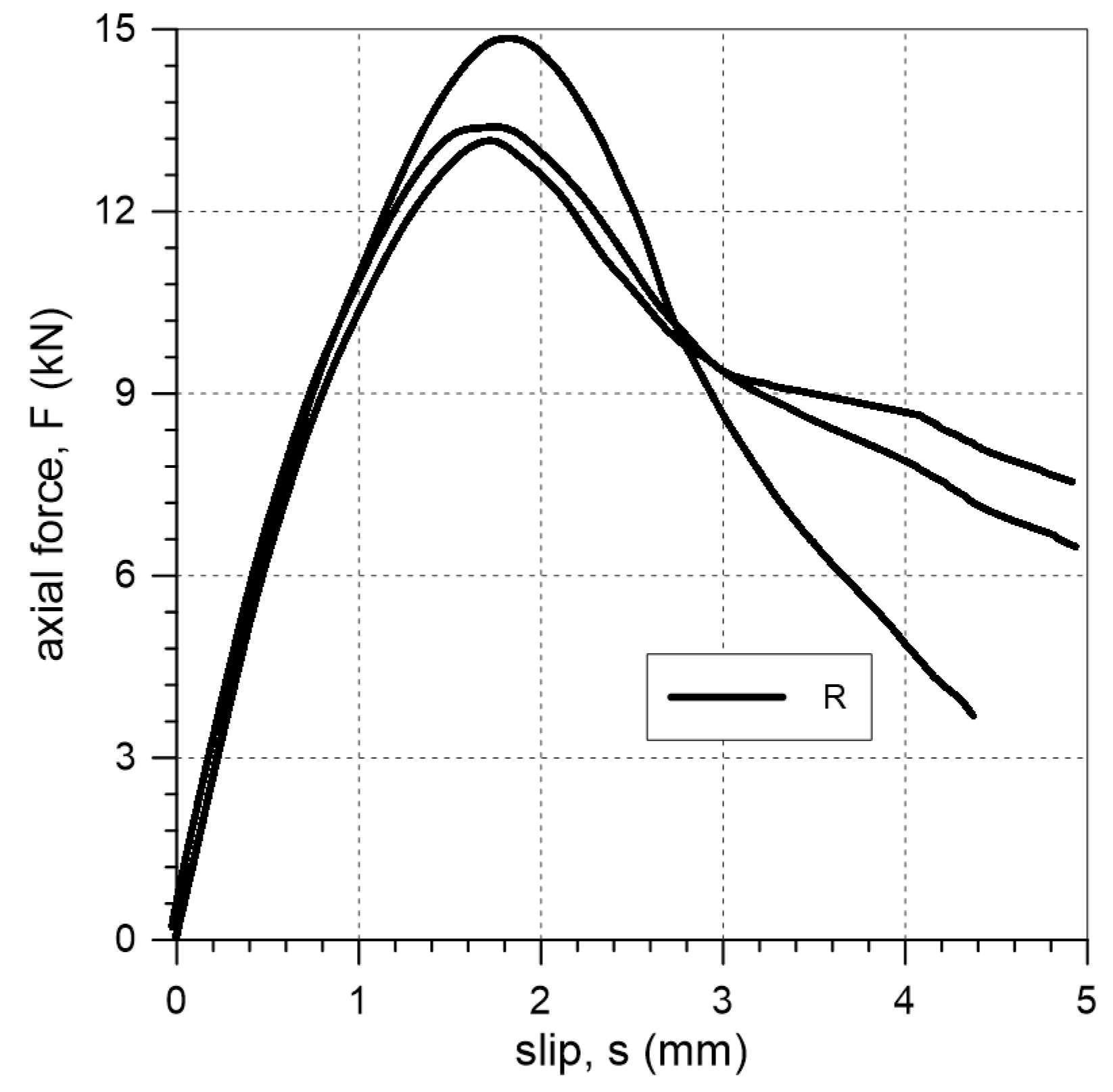
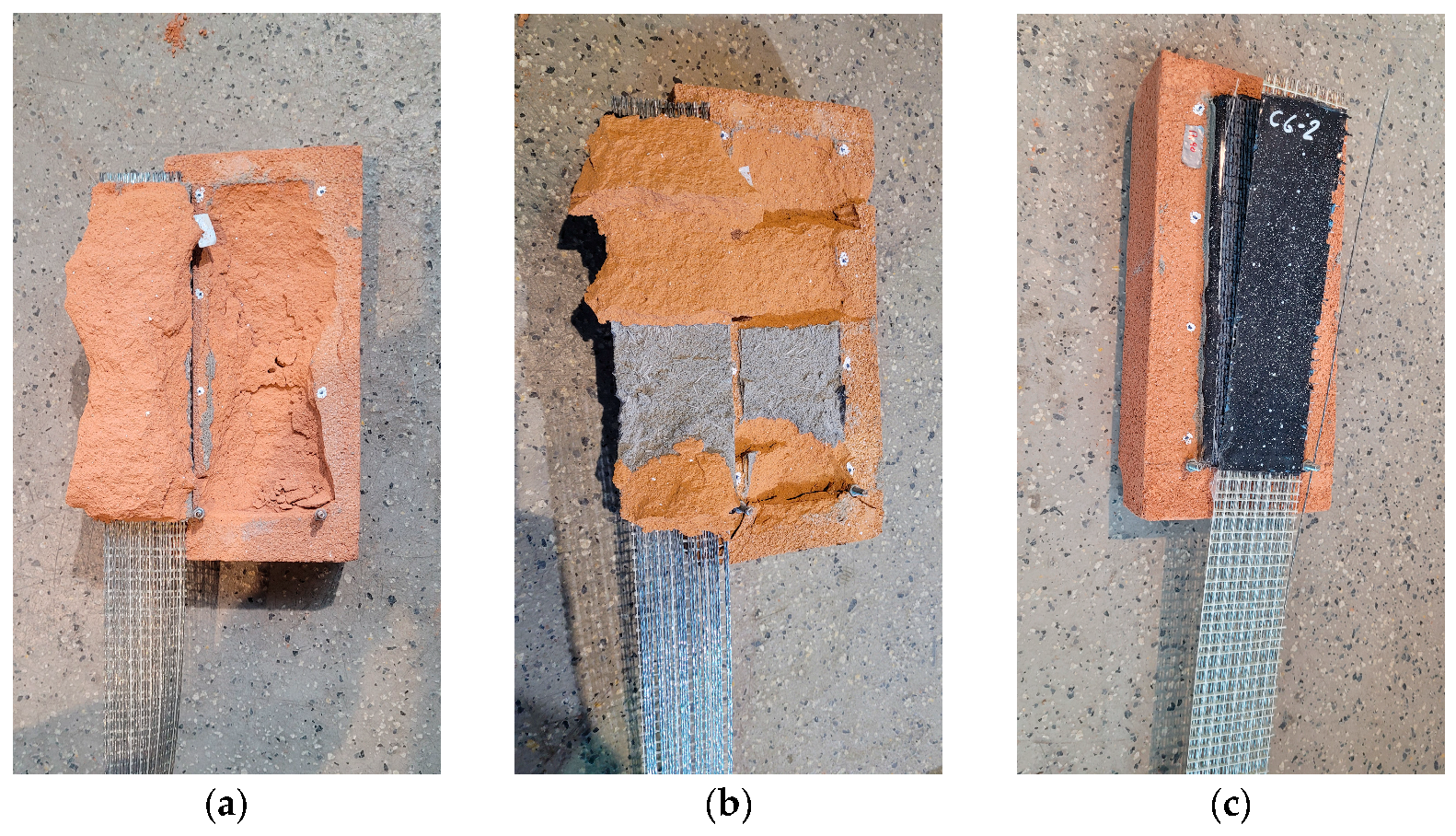
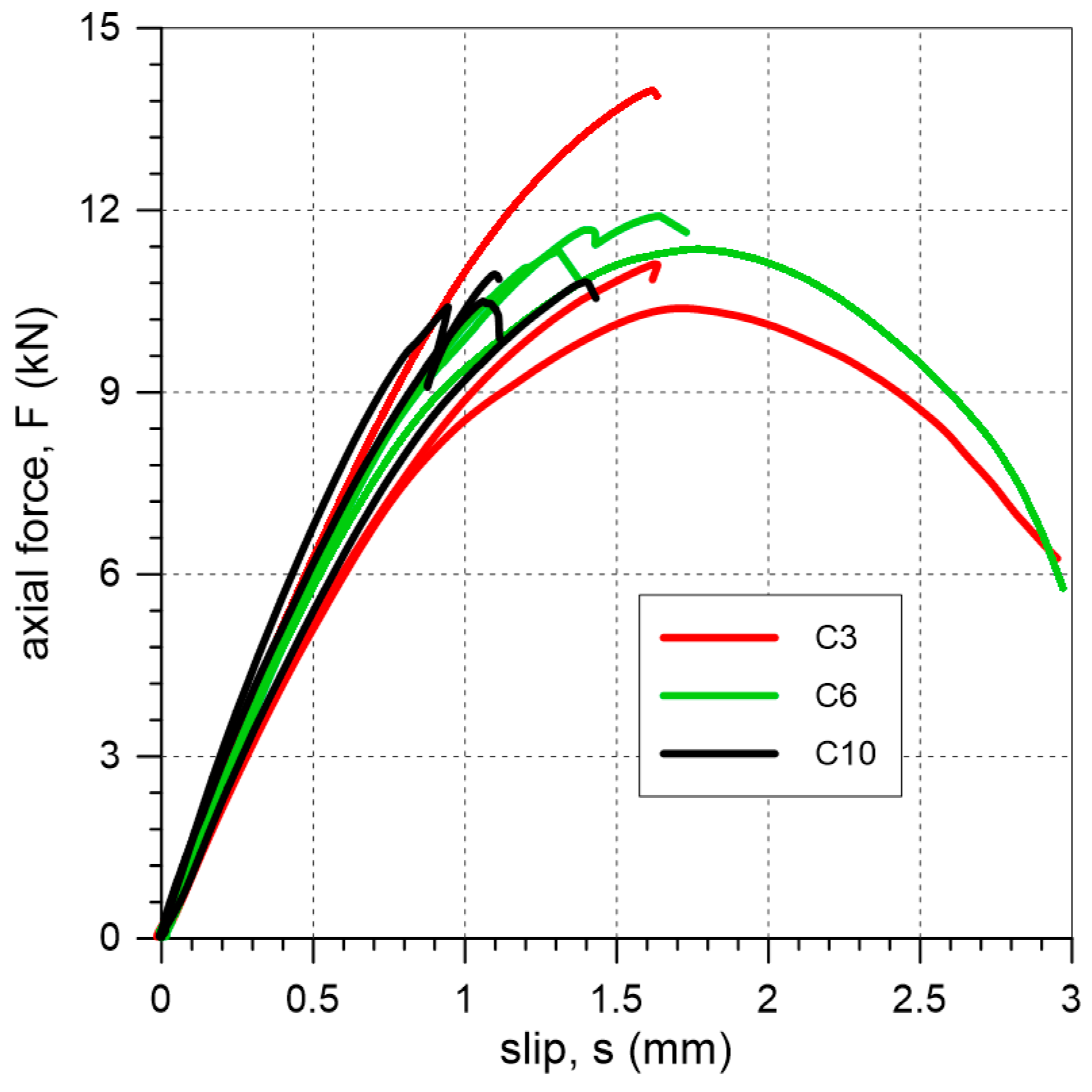


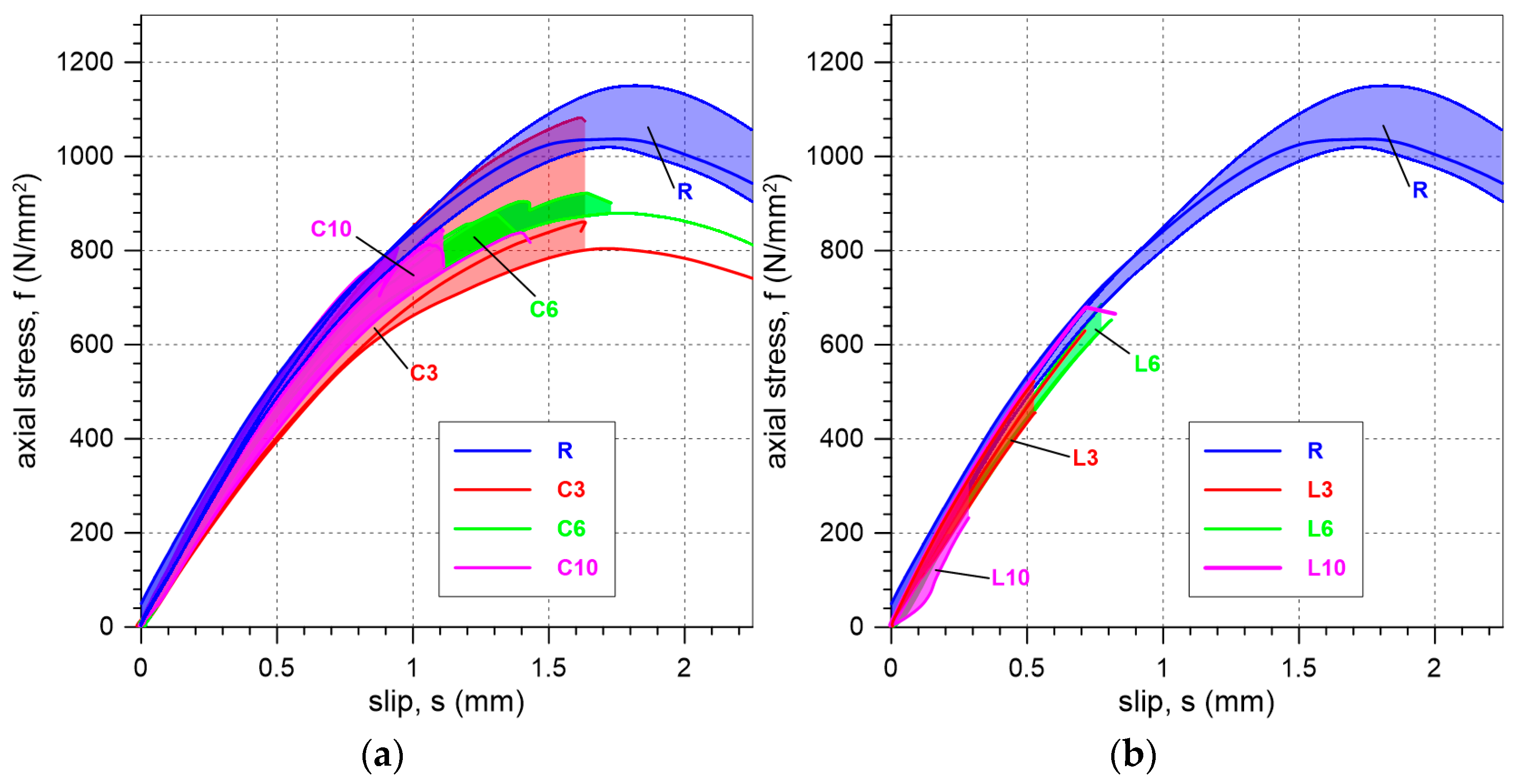
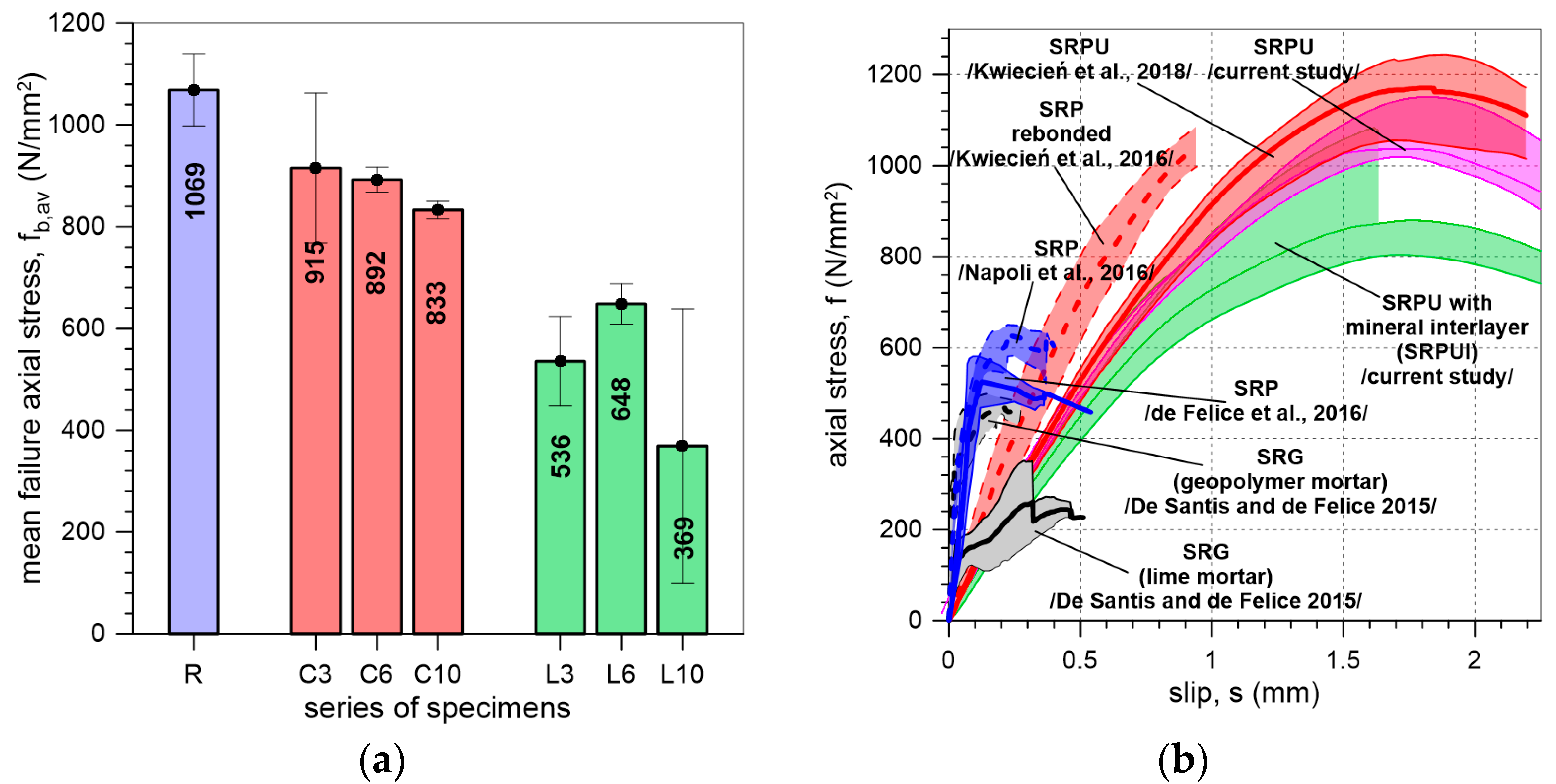
| Notation | No. of Specimens | Interlayer | Interlayer Thickness (mm) |
|---|---|---|---|
| R | 3 | - | - |
| C3 | 3 | Cement-based | 3 |
| C6 | 3 | Cement-based | 6 |
| C10 | 3 | Cement-based | 10 |
| L3 | 3 | Lime-based | 3 |
| L6 | 3 | Lime-based | 6 |
| L10 | 3 | Lime-based | 10 |
| Notation | Failure Mode | Fmax (kN) | fb (N/mm2) | fb,av (N/mm2) |
|---|---|---|---|---|
| R-1 | FM6 | 13.4 | 1037 | 1069 |
| R-2 | FM5 | 14.9 | 1150 | CV 6.6% |
| R-3 | FM6 | 13.2 | 1019 | SR 100% |
| C3-1 | FM5 | 10.4 | 804 | 915 |
| C3-2 | FM1/FM2 * | 11.1 | 860 | CV 16.1% |
| C3-3 | FM1 | 14.0 | 1082 | SR 86% |
| C6-1 | FM1 | 11.9 | 922 | 892 |
| C6-2 | FM5 | 11.4 | 880 | CV 2.8% |
| C6-3 | FM1 | 11.3 | 876 | SR 84% |
| C10-1 | FM1 | 10.5 | 813 | 833 |
| C10-2 | FM1 | 10.8 | 838 | CV 2.1% |
| C10-3 | FM1 | 10.9 | 847 | SR 78% |
| L3-1 | FM3 | 5.88 | 455 | 536 |
| L3-2 | FM3 | 8.13 | 630 | CV 16.4% |
| L3-3 | FM3 | 6.74 | 522 | SR 50% |
| L6-1 | FM3 | 7.84 | 607 | 648 |
| L6-2 | FM3 | 8.86 | 686 | CV 6.1% |
| L6-3 | FM3/FM2 * | 8.42 | 652 | SR 61% |
| L10-1 | FM3 | 8.77 | 679 | 369 |
| L10-2 | FM3/FM1 * | 3.00 | 232 | CV 73.0% |
| L10-3 | FM3 | 2.52 | 195 | SR 35% |
Disclaimer/Publisher’s Note: The statements, opinions and data contained in all publications are solely those of the individual author(s) and contributor(s) and not of MDPI and/or the editor(s). MDPI and/or the editor(s) disclaim responsibility for any injury to people or property resulting from any ideas, methods, instructions or products referred to in the content. |
© 2025 by the authors. Licensee MDPI, Basel, Switzerland. This article is an open access article distributed under the terms and conditions of the Creative Commons Attribution (CC BY) license (https://creativecommons.org/licenses/by/4.0/).
Share and Cite
Hojdys, Ł.; Krajewski, P.; Kwiecień, A. Steel-Reinforced Polyurethane with Mineral Interlayer for Masonry Protection: Laboratory Tests. Materials 2025, 18, 503. https://doi.org/10.3390/ma18030503
Hojdys Ł, Krajewski P, Kwiecień A. Steel-Reinforced Polyurethane with Mineral Interlayer for Masonry Protection: Laboratory Tests. Materials. 2025; 18(3):503. https://doi.org/10.3390/ma18030503
Chicago/Turabian StyleHojdys, Łukasz, Piotr Krajewski, and Arkadiusz Kwiecień. 2025. "Steel-Reinforced Polyurethane with Mineral Interlayer for Masonry Protection: Laboratory Tests" Materials 18, no. 3: 503. https://doi.org/10.3390/ma18030503
APA StyleHojdys, Ł., Krajewski, P., & Kwiecień, A. (2025). Steel-Reinforced Polyurethane with Mineral Interlayer for Masonry Protection: Laboratory Tests. Materials, 18(3), 503. https://doi.org/10.3390/ma18030503





